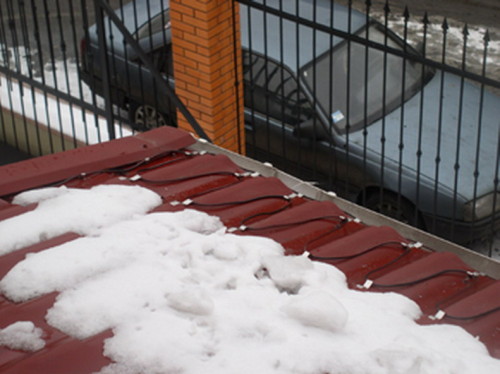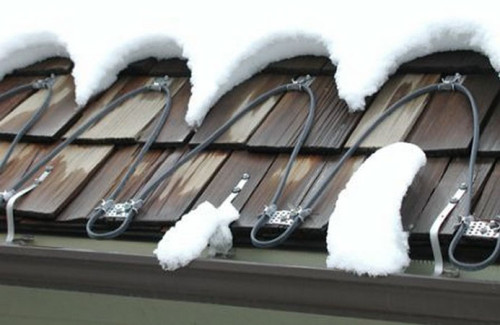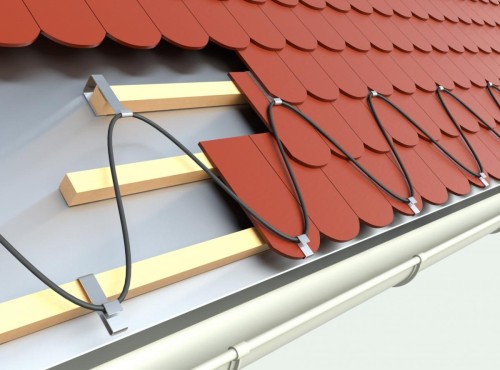To date, a very important element of the construction of any structures is arrangement of insulation and heating. Without these nuances, in the cool periods of the year, it is hardly possible to do. First of all, this refers to private homes that the wind is constantly operating, as well as many precipitation. Obviously, there are a lot of resources to prevent all negative influences, including monetary. However, it is pre-evaluating the main threats that are available at the dwelling, and after that, to make some conclusions.
Content
In this case, we will talk about the heating of the roof. This is a very important point that allows you to get rid of ice cover, which is often on the roof in the winter. Moreover, with the heating of the drainage system, the formation of icicles can be avoided, which also make up a considerable threat not only for residents of the house, but also for passers-by and objects located near the roof.
In this article, we analyze the main features of the heating of the roof, as well as consider the parts associated with the arrangement of this warming itself. It is necessary to note in advance the fact that it is quite practical and relatively inexpensive a solution that will allow a little relief life.
The main features of the heating of the roof
It should be understood that the arrangement of heating of the roof is not a modern way to stand out among other owners of homes. This is really necessary in terms of security plan, which will easily avoid major icing. It is worth noting the fact that the icing of the roof in any case must be removed, since under the large weight of the ice of the roof can be at least damage. In the worst situation, the roof can be significantly deformed. To avoid such situations and placed insulation. Accordingly, this is an exceptional security issue on which much depends on.
Approximately the same situation with the insulation of the drain. Most often, the owners make a decision to warm up immediately and roof, and drain.
If you speak directly about the drain, then in the winter, as already mentioned, large icicles are formed, or even more large-scale icing. Especially bad if there lives a lot of people in the house, and some love to walk around the plot. Annark can be a victim of the fall of icicles. This happens infrequently, but it makes sense to protect yourself. In addition, under the action of the same large weight, you can encounter a breakdown of the entire drainage system, which is often different in fragility.
Do not think that Flash appears only in the winter. Very often, such troubles are found in the spring, when there is a temperature difference between day and night. It is this situation that is the greatest threat, as in the spring it is very often raining.
As for the positive sides of the heating of the roof, it is definitely safety, both for tenants and the structure itself. Moreover, the heating system is quite economical, if necessary, it can be turned off.
If we talk about the shortcomings of such systems, it should definitely mention the complexity of their installation. Most often, they consist of a variety of small components, among which it is easy to get confused. Based on this problem, another trouble occurs, which concerns the complexity of the repair. Heating can actually stop functioning, and it will be extremely difficult to find the cause of such a problem. With this situation will have to contact the specialists.
Basic Heating Tools Roof
You can find quite a few options for heating the roof and drainage. However, not all options are distinguished by high efficiency or practicality.
- Self-regulating cable for heating roof. This is the most modern way to counter the ice, which is formed on the roof. It is also necessary to note the fact that this option of heating consists of a matrix (the very self-regulating element), an insulating shell, as well as braids and the main outer shell. Many owners prefer this particular heating option for the roof. However, it must be remembered that it is somewhat more expensive than the other types of products. But it is worth understanding that the self-regulating cable changes its temperature depending on external conditions. This allows at least to save electricity.
- Resistive roof heating cable. This is a fairly simple and inexpensive option to create durable heating. The cable consists of metal veins and main insulation. Accordingly, the temperature regime cannot be changed here, all indicators remain the same during the entire heating period. This means that this system will need to constantly monitor, otherwise you can face some problems that occur during heating fails. It should be known that the heating of the cable comes from connecting to a closed electrical chain.
If we talk about the correct selection of heating, then in this case a lot depends on the existing conditions, as well as on the scale of the structure. The two presented systems should be performed perfectly with ice, which is formed on the roof or drainage. They have approximately the same power, which is more than enough for the tasks. If you know that the heating of the roof must be carried out regularly, you should look at a self-regulating cable that will save money on electricity. If the heating is necessary only in rare cases, the resistive cable will completely come.
If you are not sure exactly what type of cable you need, it is worth consulted with specialists. Often, in the course of such discussions, items arise from which it is necessary to repel when heating is selected. If in the store consultant persistently offers the most expensive option, you can ask him to slightly specify such a choice, and after that it is conclusions.
In addition, you should pay attention to the calculation of power consumption, as well as the choice of power of heating elements. If we talk about the resistive type of cable, then the power is within 18-22 W, in the case of a self-regulating cable, the capacity is 15-30 W. As for the drain, then the power must be somewhat lower than that previously described. Most often, this value should not exceed 17 W. If the power is higher, then there is a threat of damage to the drainage, as often these structures are quite thin and fragile.
The components of the heating system of the roof
Despite the fact that the process of arising from the heating of the roof may seem fairly simple, tools and materials for this event will need a lot. First of all, these are fasteners, as well as numerous parts associated with electricity.
In this case, a shield will be required, which consists of the following elements:
- warning lamp;
- chain protection automatic;
- four-band contactor;
- input protective three-phase automatic machine;
- single-band automatic protection for each of the phases;
- devices for protective disconnection of the entire system.
It also needs to be borne in mind that in this case the following distribution network components are necessary:
- mounting boxes;
- couplings for sealing compounds;
- signal cables;
- strength cables;
- thermostat.
As for the thermostat, then often the hosts set the temperature regime in the range from -5 to +3 degrees.
Also used meteorological station. This is an installation that analyzes the environment. It is able to establish that the melting of snow begins on the roof or the presence of a large amount of precipitation. After that, heating begins to work and gradually remove the precipitation from the roof. The meteorological station is equipped with a humidity sensor that accurately establishes an external situation.
If it is decided to use the usual thermostat, the heating will always work in one temperature mode. As for the meteorological station, it is necessary if it is necessary to fully automate the process of heating the roof. It should be borne in mind that often similar steps are not used, as they are associated with major financial costs. In any case, the choice of components of the heating of the roof depends solely on the existing situation. Perhaps in some cases, precipitation is too serious.
Installation of the roof heating system
Location of heating cable
Obviously, heating is needed only in those places where it is formed. Often these places are angular zones. It is absolutely necessary to cover the entire area of \u200b\u200bthe roof with a warming cable. This is not only expensive, but also ineffective. Finding, which is formed on the roof, is often closer to the waterproof. Accordingly, it is enough to cover the cable zone near the drain (area in 1 m toward the top of the roof). It should be noted in advance that the heating is installed only on the pitched roofs.
It is also necessary to stretch the heating cable along the drainage gutters. Most often one cable is enough, but if the scale is large, then you can stretch a few. As for the power supply, in this case it should be from 200 to 300 W per square meter.
In the drainage pipes, it is also very often formed to frighten. It is for this reason that the pipes are deformed either at all fall off. All this happens under the action of ice weight. Thus, in this zone it will not prevent heating. It is enough to install only 2 low power cables.
If the house is large, then he is definitely present. In these zones, ice is also formed, and in large volumes. Thus, we will need to cover 2/3 of the length of this element so that the ice does not make any danger of the structure.
As for the arrangement of heating on the roof itself, then the styling occurs according to the "Snake" scheme. This allows you to be sure that the ice will not accumulate on the roof.
Of course, the situation can vary significantly depending on the specifics of the structure and weather conditions.
Arrangement of heating
- At the very beginning, the warming cable is attached to the drainage gutters. Fasten in this case, the cable is necessary using the mounting tape. Of course, it is desirable to choose a greater thickness tape so that the connection is lasting longer. If several tapes are set, the step should be at least 0.25 m. It also does not prevent fixation using rivets using the sealant.
- Next, you can carry out the installation of heating based on the roof. The cable is mounted directly on the roofing material using a mounting tape, as well as sealant. In this case, it is necessary to accommodately approach the location of the cable, since it is precisely from this that the ice effectively will melt. It is desirable to install a cable according to the "Snake" scheme, which we talked earlier. The step between the heating zones should be equal.
- When the cable is installed in the drainage pipe, you need to keep in mind that the installation occurs with the mounting tape or heat-suite tube. It is often happening that the drainage pipe has a huge height. With this scenario, the cable must be attached to the metal cable, which will easily take on the carrier loads.
- Before the installation of the cable to the surface, you should make sure that we have no sharp or other items that may damage the heating.
- When installing a mounting box, small tests immediately conduct, which allows you to quickly establish possible problems, which are not so rare.
- Next takes place the thermostat sensors, after which the laying of the power cable is done.
- Now you need to install the control panel, immediately tested the equipment. After that, the thermostat is carried out.
- Next, there is a connection of all components of the system and the overall performance test.























